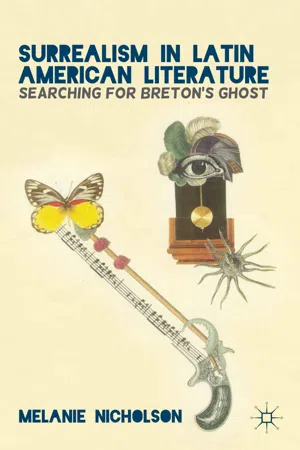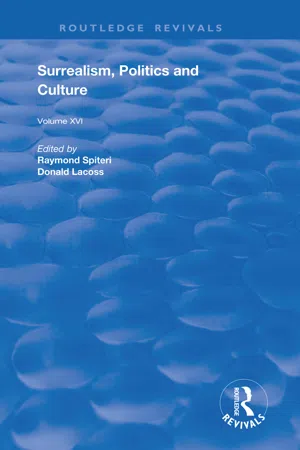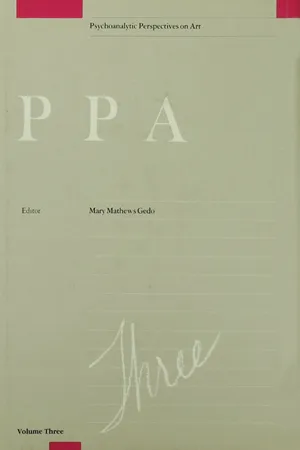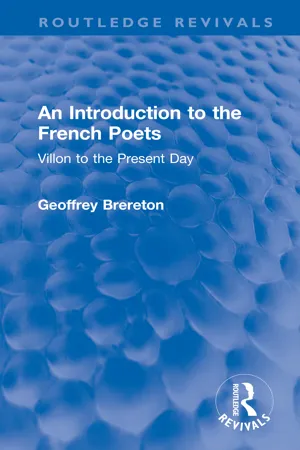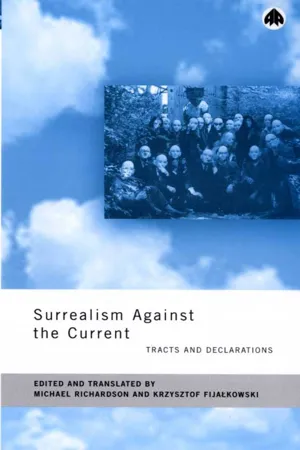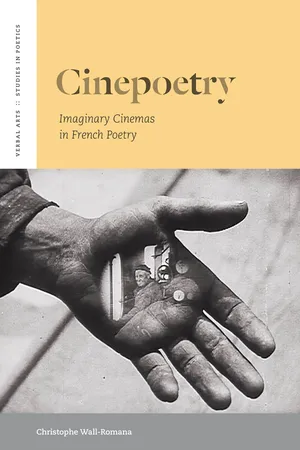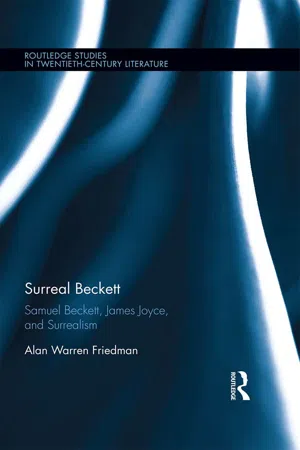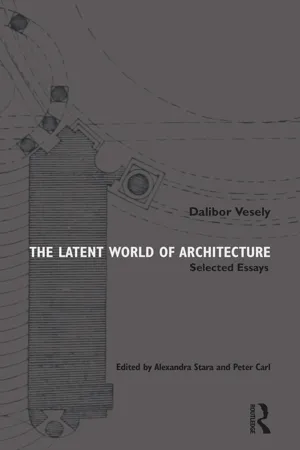Literature
Surrealism
Surrealism is a literary and artistic movement that emerged in the early 20th century, characterized by its exploration of the unconscious mind and its rejection of rationality. Surrealist works often feature dreamlike imagery, unexpected juxtapositions, and a focus on the irrational and fantastical. This movement sought to challenge conventional artistic and literary norms, aiming to unlock the creative potential of the subconscious.
Written by Perlego with AI-assistance
10 Key excerpts on "Surrealism"
- eBook - ePub
Surrealism in Latin American Literature
Searching for Breton's Ghost
- M. Nicholson(Author)
- 2013(Publication Date)
- Palgrave Macmillan(Publisher)
Manifesto of Surrealism , says Michael Benedikt, was “as productive to the growth of Surrealism beyond its early years as any deliberate allowance for variation” (xvii). Roger Shattuck emphasizes the important role of these unresolved antinomies when he suggests that “the excitement of the surrealist object or work is its attempt, not to obliterate or climb higher than the big contradictions, but to stand firmly upon them as the surest ground” (“Introduction” 22). This excitement—embracing both devoted enthusiasm and bitter vituperation—established Surrealism’s place as the latecomer but also the late-stayer among avant-garde movements.Defining Features of Surrealist ThoughtBy the late twentieth century, the adjective “surreal” had settled itself in English parlance as a general name for the odd, the unexpected, or the absurd. Surrealism’s founders, however, had in mind something much more specific, and any study of the movement and its sequelae must address itself to these original intentions. The following pages present the key tenets of surrealist thought as it developed in France in the 1920s and 1930s, which will serve as a foundation for a more extended look at Latin American surrealist literature.Surrealism was originally conceived not as a literary or artistic school, much less a set of techniques or a mere style. It was rather a mode of thought that was meant to subvert all conventional modes of thought and even to change the nature of thought itself. The most sustained effort at explaining Surrealism conceptually is Ferdinand Alquié’s The Philosophy of Surrealism , first published in French in 1955. Alquié observes that Surrealism “involves an authentic theory of love, of life, of the imagination, of the relations between man and the world” (2). For him, “all this supposes a philosophy,” an assumption that allows Alquié to reconcile his admiration for Breton—the movement’s “intellectual and reflective consciousness”—with his admiration for Plato, Descartes, and Kant (2, 4). The Philosophy of Surrealism - eBook - ePub
- Raymond Spiteri, Donald Lacoss, Raymond Spiteri, Donald Lacoss(Authors)
- 2020(Publication Date)
- Routledge(Publisher)
Not that the Surrealists ever had a decisive effect on the course of political events, or made any original contribution to political theory. The interest in the movement’s political history lies in its tenacious efforts, set forth in some highly articulate polemical writing, to associate its intellectual, artistic and moral preoccupations with the aims and methods of international Communism. The issues at stake may be reduced to three: the reconciliation of a generalized spirit of revolt with revolutionary action; the reconciliation of the idea of a ‘spiritual revolution’ and its accompanying insistence on ethical ‘purity’ with the practical necessities of political effectiveness; and the reconciliation of an independent revolutionary art with the demands for propaganda and didacticism made by the Communist Party. An examination of them will show how the evolution of the theory of Surrealism, an enterprise which was initially and essentially poetic, led the movement to call for the transformation of society; and an account of Surrealism’s ventures into politics and of the repeated setbacks these met with, will suggest some of the reasons why the Surrealists failed to translate their metaphysical and spiritual ambitions into social terms, and, more specifically, why they failed to find a permanent place within the Communist movement.While in the narrow sense, according to the definition in Breton’s Manifesto of 1924, Surrealism appeared to be no more than a new poetics, a linguistic experiment and a novel method of ‘forcing inspiration’, in the broad sense it implied an ethics, a philosophy and a politics. Bringing together Rimbaud’s ‘Lettre du Voyant’, Hegel’s dialectical method, and Freud’s analysis of the unconscious, the Surrealists began by making a drastic revaluation of the poetic image. They believed that the series of images which they brought to light by using automatic techniques represented the ‘real process of thought’. They devoted themselves to the exploitation of the untapped resources of the unconscious, hitherto ignored or suppressed by a culture obsessed by technological progress and material comforts. For the Surrealists, poetry was not a cultivated form of escapism; it was an instrument of discovery. Insofar as the source of poetic inspiration was the unconscious mind, a faculty which, like Descartes’s reason, was common to all men, they believed that poetry could be ‘made by all’ and not just by the technically accomplished litterateur. It had ceased to be a ‘means of expression’ and had become ‘an activity of mind’.From the moment poetry was conceived as a spiritual activity accessible to all men, it ceased to be a purely aesthetic matter and became an ethical one. In Paul Éluard’s words: ‘Toute veritable morale est poétique, la poésie tendant au règne de l’homme, de tous les hommes, au règne de notre justice’. Surrealism thus affirmed the ethical basis of all expression and the ‘Communism’ of poetry. At the same time, poetry’s roots in the unconscious meant that it was the expression not only of primal mental activity but of man’s deepest desires as well, for the unconscious was also the seat of the instincts and the libido. As such, poetry could not remain at the abstract level of ‘fine art’. As the expression of desire, it involved choices and demands which sought satisfaction in the real world. Far from being a compensation for an inadequate and unworthy reality, poetry represented that towards which reality should progress. The Surrealists were confident that once the mind had a vision of what was possible, the will would struggle to achieve it, and that the ‘interpretation’ of man and of the world would inevitably be accompanied by their transformation. The poet would lead the struggle to raise man’s spiritual and social state up to the level of his dreams. In so far as the disparity between that which existed and that which was desired was the result of alterable social conditions rather than of an immutable human condition, the Surrealists came to demand a radical social upheaval: a revolution. - eBook - ePub
- Mary M. Gedo, Mary M. Gedo(Authors)
- 2013(Publication Date)
- Routledge(Publisher)
“They are,” he said, “people of a scrupulous honesty, and whose innocence is equaled only by mine. Columbus had to sail with madmen to discover America. And see how that folly has taken form and endured” (quoted in Waldberg, 1965, p. 16). (In that era Breton could say this without irony.) So there was in Surrealism the belief—partly derived from Hegel—that ultimately opposites might be reconciled in some new synthesis of superrealism which would restore a natural, meaningful balance to human life individually and collectively.Surrealists absorbed themselves with messages and clues from the mental interior wherever they might emerge: in symbolism, automatic writing and drawing (graphic and pictorial language were often combined), spontaneous absurdity and incongruity, and other expressions of apparent irrationality—consistent, incidentally, with Freud’s description of unconscious thought—such as condensations of past, present, and future time; the commingling of opposites; the equation of parts with wholes; and the celebration of uninhibited amoral impulsiveness. The outcomes of these activities were sometimes inspired and sometimes contrived, as if copied out of a dream book.Surrealism has been divided, somewhat artificially, into two general forms, the emblematic (or automatic, or accidental) and the naturalistic (or intentional) (Waldberg, 1965, pp. 8, 38). The emblematic involved spontaneous and unmodified imagining by means such as automatic writing or drawing. Surrealist naturalism employed symbolism and other apparent manifestations of the irrational unconscious mind, spontaneous in origin yet controlled in expression, realistically depicted in a setting of traditional representation, so that a bizarre effect—and a new world, objectifying the world of dream—was created by the incongruous union of the two levels of thought. To understand this better, we might briefly recall the psychoanalytic description of the mind’s topography (Freud, 1900). According to this theory psychological life in the human being emerges out of a primordial unconsciousness and thereafter moves toward a hierarchy of mental contents through accumulations of experience. In the first months and years of life the infant learns that ruthless impulses are unacceptable to parents and others; as a consequence these impulses and whole constellations of thought and feeling connected with them may be relegated to unconsciousness. Experience not repressed resides in an area of the mind called the preconscious, which is accessible to consciousness simply through an effort of attention. Preconscious mentation derives importantly from the child’s relationships with others; consequently it develops a close structural connection to language. Consciousness itself was viewed by Freud as an instrument to scan preconscious contents for relevant information. - eBook - ePub
An Introduction to the French Poets
Villon to the Present Day
- Geoffrey Brereton(Author)
- 2022(Publication Date)
- Routledge(Publisher)
Manifeste du surréalisme (1924). Surrealism aimed at expressing more of the true personality than had ever been attempted before. Freud seemed to have placed a wonderful new key to human nature in the investigator’s hand. It was simply necessary to liberate the unconscious in all the activities of daily life. Of these activities, literature was only one, and not necessarily the chief. Its role in the early history of the movement was limited to the transcribing of dreams and to writing ‘automatically’ in a dazed or trance-like state.Thus Surrealism, viewed historically, was the third great step in a hundred years towards the ‘liberation’ of art. The first had been taken by the Romantics, the second by the Symbolists – who had come very near to the discovery of the unconscious, even if they did not name it. Each movement aimed at giving fuller and therefore truer expressions to the human psyche, and each has achieved a progressive relaxation in form, so that with the Surrealists this aspect of ‘liberation’ comes near to dissolution. As a consequence of their doctrine, the Surrealists discarded all concern with form, since such a concern implies a conscious preoccupation with the means of expression, to the detriment or distortion of the spontaneous thing expressed. Prose, then, written without premeditation, or the loosest kind of free verse, were used because they seemed the most convenient media and, naturally, no stress was laid on a distinction between verse and prose.At this point a detached observer might remark: ‘Surrealism makes poetry very easy. You simply have to shut your eyes and write.’ And he envisages an idle, effortless process, empty of all the qualities associated with the exertion of the will. Yet the words which most often recurred under the pens of French critics writing of Surrealist and allied poetry were, first, revolution, which is understandable in both the social and the literary contexts; and, equally, adventure, risks, dangers and even hero-poets. What was heroic or even risky in drifting with the stream of the unconscious? Briefly, from the Surrealist point of view, it meant a plunge into the unknown and so spelt a dangerous adventure similar to the kind that Rimbaud attempted. But for the Freudian Surrealist the unknown was to be found entirely within the self and it was not the contacting of it (as for Rimbaud) which was either dangerous or arduous. It was rather that, after contact, the whole of the self was laid bare and committed. The writer’s psyche is - eBook - ePub
Surrealism Against the Current
Tracts and Declarations
- Michael Richardson, Krzysztof Fijalkowski, Michael Richardson, Krzysztof Fijalkowski(Authors)
- 2001(Publication Date)
- Pluto Press(Publisher)
This perception may be said to be the foundation of Surrealism, announced in the first major collective declaration given by the surrealists: ‘We have nothing to do with literature, but when necessary we are as capable as anyone else of making use of it’ (see p. 24). Not a new poetic form, Surrealism was ‘a cry of the mind turning back on itself and it is determined to smash its fetters’ (ibid.). Despite this insistence, which Surrealism consistently maintained as among its first and most determining principles, it is precisely as a poetic form that many critics have sought to judge it. Yet the specificity of Surrealism can hardly even be considered in such terms. If Surrealism has any meaning – at least in terms understood by the surrealists themselves – it is precisely due not simply to the rupture it made with traditional ideas of the role of the artist; it also involved a clear break with the modernism of which Dada was the most radical expression. It is in this refusal to be confined within poetic form (even an anti-poetic form) that the specificity of Surrealism must be sought, and it is also this that marks it off from the intellectual movements that preceded it and, indeed, from those that followed it. And this investigation – an investigation founded in revolt and rage – was above all to be centred in a rejection of an Enlightenment individualism which, during the nineteenth century, had led to art being considered the product of genius. In reaction, for Surrealism, poetry was seen as the preserve of all, founded in a collective endeavour whose interstices also needed to be explored collectively - eBook - ePub
- Nathalia Brodskaïa(Author)
- 2015(Publication Date)
- Parkstone International(Publisher)
In 1925, there also occurred an event of exceptional importance: the first joint exhibition of Surrealist painting was held in Paris at the Galerie Pierre. The artists involved were Arp, de Chirico, Ernst, Klee, Man Ray, Miró, Picasso and Pierre Roy. It was the beginning of the succession of displays of painting and sculpture that make it possible to speak of Surrealism both as a phenomenon and at the same time as the union of diverse and outstanding aesthetic talents. In the same year, the Galerie Pierre organised an exhibition of Juan Miró. On 26 March 1926, the Galerie Surréaliste was solemnly opened, and it showed work by Duchamp and Picabia, as well as those artists already named. In 1928, the Galerie Bernheim put on an individual exhibition of Max Ernst. The ranks of the Surrealist artists in Paris were reinforced by incomers from other countries. In 1927, René Magritte arrived from Belgium. In 1928, Salvador Dalí came from Spain to Paris for the first time, and he had his first personal exhibition in Paris in 1929. In 1931, Alberto Giacometti, a native of Switzerland, exhibited his Surrealist sculpture-objects for the first time. The Surrealist artists illustrated books, painted scenery for contemporary theatrical productions, and made Surrealist films. It would be fair to say that at this stage, the Surrealists’ creative work pointed in different directions: literature ceded pride of place to the visual arts which were steadily gathering momentum.However, Surrealism as a movement had already experienced the moment of its triumph. Even in the early stages, absolute unity had not been one of its characteristics, but now disagreements were becoming increasingly acute. The events in the political and social life of Europe at the beginning of the twentieth century were bound to be reflected in a movement which took such an uncompromising, even anarchist position on the subject of the bourgeois world. First the Revolution in Russia and the wave of unrest that hit the whole of Europe as a result, along with Lenin and Trotsky’s writings; then the war in Morocco, and the necessity for the French intelligentsia to determine their own position in relation to it – all this provoked not only heated polemics from the Surrealists that were directed against other groups of intellectuals in Paris, but also sharp disagreements within the movement. It seemed as though the Surrealists only had to go one step further before they found themselves moving into social and political activism. In any event, in the middle of the twentieth century they left their ivory tower, feeling that they had a bond with the destructive forces of the revolution. “The authentic art of today is hand in glove with the social function of revolution: art, like the latter, aims to confuse and to destroy capitalist society”, Breton wrote.[60] In this situation, the question arose: what in practical terms could the Surrealists accomplish? Pierre Naville put this question in his article, “Intellectuals and the Revolution”. According to him, the Surrealists had the choice of two directions: “either to persist in a negative attitude along anarchist lines, a false attitude from the outset because it does not justify the idea of revolution which it proclaims, an attitude which is subordinate to the refusal to compromise one’s own existence and the sacred character of the individual in a fight which would lead towards the disciplined action of the class struggle; or, commit oneself resolutely to a revolutionary course, the only revolutionary course, the Marxist course.”[61] - eBook - ePub
Cinepoetry
Imaginary Cinemas in French Poetry
- Christophe Wall-Romana(Author)
- 2013(Publication Date)
- Modern Language Initiative(Publisher)
Chapter Five: Breton’s Surrealism, or How to Sublimate CinepoetryAt that time [in 1916], all we saw in cinema, whatever its kind, was a lyrical substance requiring massive random reshuffling [une substance lyrique exigeant d’être brassée en masse et au hasard ].—André Breton, “As in a Wood,” Œuvres complètes , 19511“In 1924,” Gérard Durozoi writes, with a poke at Marx, “a specter haunted Paris—at any rate, the specter of Surrealism.”2 That specter haunts today’s poetry studies in French, the criticism of international modernism and theories of the avant-garde, whether in writing, art, or film. André Breton was of course the main theoretician of Surrealism.3 He might be more properly considered its scriptwriter and director since cinema, and even more so cinepoetry, have played a constitutive role in the orientation of the movement as well as in its formal and conceptual innovations, particularly automatic writing, associative leaps, the marvelous image, collagism, and the “exquisite corpse” game. Because that contribution was erased and silenced by Breton, we might say that Surrealism, in turns, was haunted by cinepoetry.Specifically, Breton made four related moves: first, he recuperated cinepoetic writing’s experimental thrust between 1917 and 1924 by bringing leading cinepoets into his movement; second, he campaigned against independent cinepoetic practitioners and theoreticians in the Paris world of letters; third, he decoupled cinepoetry from the cinema apparatus to reshape and sublimate it via the immateriality of the Freudian unconscious; and lastly, after 1925 he authorized or collaborated in limited cinepoetic experiments and a handful of films, but only when it was clear that his theory informed them - eBook - ePub
Surreal Beckett
Samuel Beckett, James Joyce, and Surrealism
- Alan Warren Friedman(Author)
- 2017(Publication Date)
- Routledge(Publisher)
1 Surrealism’s Origins and EvolutionWhat was this Surrealism that Beckett inherited? Mary Ann Caws calls the Modernist era in Western Europe – which I date from roughly 1880 to the outbreak of World War II, but which she extends into the 1980s – “a century of isms.” Manifestoes proclaiming Symbolism, Dadaism, Futurism, Expressionism, Primitivism, Cubism, Vorticism, Constructivism, Suprematism, Vitalism, Imagism, Eroticism (and, of course, Fascism and Communism), as well as numerous others, appeared with great frequency and enthusiasm, usually signed by multiple adherents. Surrealism was one of the most important and wide-spread of these movements; in fact, Caws writes, “No movement in French Modernism has had a greater impact on cultural life.”1 Surrealism is commonly viewed as having begun ob ovo in Paris in reaction to the bloodshed, ruin, and futility of the Great War, as well as to the chauvinism, “rationality,” religion, and hypocrisy that triggered the war. But Surrealism had deeper and older roots. Its acknowledged precursors include the nightmarish paintings of Hieronymus Bosch (1450–1516), who has often been called the first Surrealist (Figure 1.1 ); the writings of Gérard de Nerval (1808–55) and Comte de Lautréamont (pen name for Isidore-Lucien Ducasse; 1846–70); late-nineteenth-century French Symbolist poetry (especially Charles Baudelaire, Jules Laforgue, Stéphane Mallarmé, Arthur Rimbaud, Paul Valéry, and Paul Verlaine); Alfred Jarry’s Dadaist play Ubu roi (1896), which Apollinaire praised for its new and ridiculous form of humor and lyricism; the art of the Italian painter Giorgio de Chirico (1888–1978); and August Strindberg’s dream-like symbolist drama, A Dream Play (1901; first performed in 1907).Figure 1.1Hieronymus Bosch (1450–1516), The Garden of Earthly Delights (1490–1510).Strindberg, a Symbolist and Mystic, established a small theater in Stockholm, called the Intimate Theatre, where he produced his plays without props or scenery. Like Chekhov’s Three Sisters , Strindberg’s A Dream Play depicts a character who, Godot-like, waits (by a tree that loses, suddenly regains, then again loses its leaves before turning into a hat tree and then a candelabrum) for something that never happens. Scenes repeatedly dissolve into each other like dream images until, toward the end, the goddess who has been visiting the earth pronounces that “the world, existence, mankind, are nothing but a phantom, an appearance, a dream-image.”2 Having seen Roger Blin’s production of Strindberg’s The Ghost Sonata (1949–50), which was considered faithful to both the letter and spirit of Strindberg’s work, Suzanne Deschevaux-Dumesnil, Beckett’s future wife, offered Blin both Waiting for Godot and Eleuthéria for possible staging. Beckett, unusually, saw Blin’s staging of Ghost Sonata twice, though, according to Enoch Brater, “only after and because Suzanne Beckett brought Blin the Godot typescript.”3 - eBook - ePub
- Moritz Baßler, Benedikt Hjartarson, Ursula Frohne, David Ayers, Sascha Bru, Moritz Baßler, Benedikt Hjartarson, Ursula Frohne, David Ayers, Sascha Bru(Authors)
- 2020(Publication Date)
- De Gruyter(Publisher)
47 ‘Iconolatry’ rather than ‘iconoclasm’ becomes therefore Calas’ criterion for evaluating art as a rebellious externalisation of interior life, since it is the image that could ultimately mobilise personal and social change.Calas explores the function of the image more rigorously in “Image and Poetry” (1965). 48 He argues that painting creates its own reality that is homologous to the external world, yet it never imitates that world. Poetry, on the other hand, does not produce its own images, but rather inserts images into the primordial structure that is language. Calas gives us a history of the image in painting and poetry from prehistoric civilisations to Surrealism, identifying similarities and differences in these two artistic media, but also exposing his belief that an imagistic structure underpins all artistic forms. Explicitly critical of nonrepresentation, he values the image as a poetic tool in the hands of artists aspiring to transform reality to a super-reality that signals a topos of endless becoming. Calas’ endorsement of Breton’s philosophy of immanence is eloquently articulated in “The Point of the Mind: Andre Breton” which he wrote after the former’s death in 1966. 49 This essay focuses on the Bretonian supreme point as the mental point at which all antinomies are resolved. For example, he writes: “Breton felt that the poet’s vocation is to invoke emotional states in which the conjunction of opposites becomes a lived experience of reality”.50 Calas is quick to criticise contemporary critics who interpret Surrealism as an aesthetic current that sought to distance itself from reality. On the contrary, Calas argues, Breton and the Surrealists despised aesthetics and sought the supreme point within reality, not beyond it. Objective chance is the means by which the Surrealist can create art that always corresponds to reality either in symbolic or figurative terms, while non-figuration is incompatible with art.51 - eBook - ePub
The Latent World of Architecture
Selected Essays
- Dalibor Vesely, Alexandra Stara, Peter Carl, Alexandra Stara, Peter Carl(Authors)
- 2022(Publication Date)
- Routledge(Publisher)
10 Surrealism and the Latent World of CreativityDOI: 10.4324/9781003272090-11It was the belief shared by all Surrealists that the truth of dreams, myth and marvels stands above the truth of contemporary logic, which can be applied only to the resolution of problems of secondary interest. This was the point of departure for the development of a different understanding of truth and creativity that addresses the dormant (latent) sphere of reality accessible through pre-reflective experience. The most popular and best-known Surrealist creative tool, which was key to the dream-like state of mind, had been discovered in direct inspiration from a psychoanalytical method of free association and became known as ‘pure psychic automatism’, rooted in the life of dreams. Dreams have all the qualities that the Surrealists were searching for. They have the inexhaustible richness of spontaneous associations and the ability to transform conventional reality into fantastic reality, but most of all dreams are infinitely poetic. At the beginning, it was not yet realised that dreams also have the authenticity of an encounter with the great cosmic symbols, sky, earth, water, trees, stones, and with the origins and ends of things, which are the same as myths. The world of dreams was for the Surrealists a true substitute for the whole outside world.However, the Surrealists soon discovered that the long practice of automatism led to problematic states of hypnosis; the text tended to be meaningless, or, to use the expression of Michel Leiris, ‘inorganic’. It also became clear that the quality of the results did not depend so much on the technique as it did on the power of imagination and the gift of expression of the author. André Breton himself never expressed scepticism about automatism. Nevertheless, in later formulations he changed substantially its original meaning. ‘It is possible for automatism’, he writes in 1934, ‘to enter into the composition of a painting or a poem with a certain degree of pre-meditation.’1 The reference to pre-meditation indicates a new stage in the development of the Surrealists’ understanding of creativity. This new stage is usually described as a stage of surreal encounters, or ‘objective chance’ (objet trouvé).2
Index pages curate the most relevant extracts from our library of academic textbooks. They’ve been created using an in-house natural language model (NLM), each adding context and meaning to key research topics.
Explore more topic indexes
Explore more topic indexes
1 of 6
Explore more topic indexes
1 of 4
